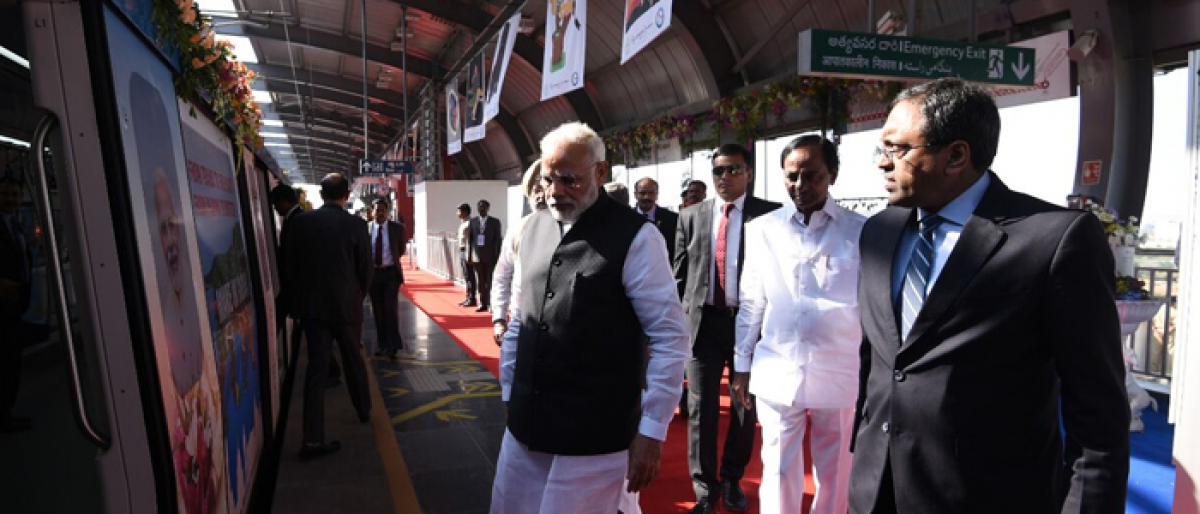Live
- UpStudy: The Smart Solution for Homework Hassles
- Actress Rithika and models inaugurate Sutraa Lifestyle Exhibition
- Loud campaign
- Faculty students celebrated english literature day in Government Degree College
- Huge fire accident.. Shops of street vendors burnt in the fire
- Pawan Kalyan promises to protect the coastal area from sea erosion
- EC Transfers Two Senior IPS Officers in AP ahead of Elections
- DMK analysis predicts victory for INDIA bloc in TN but concedes gains for BJP and NDA too
- India showcasing innovative technologies at World Energy Congress
- IPL 2024: Mitchell comes in for Ravindra as Lucknow opt to bowl first against Chennai
Just In

With the inauguration of the first phase of Metro Rail by Prime Minister Narendra Modi on Tuesday, Hyderabad has one more mass transport system to minimise chaos on city roads. Currently, RTC and MMTS are meeting commuting needs of lakhs of people. But the two popular modes of transport have proven their inadequacy to cater to the daily transport requirements of a burgeoning population spread over
With the inauguration of the first phase of Metro Rail by Prime Minister Narendra Modi on Tuesday, Hyderabad has one more mass transport system to minimise chaos on city roads. Currently, RTC and MMTS are meeting commuting needs of lakhs of people. But the two popular modes of transport have proven their inadequacy to cater to the daily transport requirements of a burgeoning population spread over a vast area. With Metro as third alternative, the daily hassle of commuting should ease considerably.
Will it or not depends on how well all areas are linked or connected to Metro stations. For example, the 30km stretch of the first phase of Metro that became operational on Tuesday between Miyapur and Nagole has 24 stations, providing access to some of the most commercially, educationally and technically important areas which are densely populated. While Metro gives the much-needed relief to those going to these places, users have some unanswered questions. The most important among these is point-to-point access. That is, home-Metro-office and back. If one has to use a vehicle to reach a Metro station, there is no sign of enough parking spaces being provided nearby. If this problem is not addressed as soon as possible, we will end up creating a new problem, solving the old one!
Assurances have been given, of course, that mini buses will be introduced from every area to the nearest Metro station to obviate the expected difficulties commuters face. Also, in the Hi-Tech City areas, smart bikes have been introduced to facilitate techies’ easy movement between Metro and work place. That’s a laudable green initiative, but the roads need cycle tracks to ensure riders reach their destinations safely. These issues are important for the successful implementation of all the phases of Metro project.
When all the routes are opened to public, and more and more people start using Metro, new problems are bound to crop up and if the initial issues are not resolved now, they will precipitate and defeat the very purpose for which Metro has been built at an enormous cost.
Notwithstanding the teething troubles that every mega project of the magnitude of Hyderabad Metro will have, it stands as a testimony to Telugu people’s pride. Built on public-private partnership (PPP) model, it showcases how joint efforts can achieve amazing results in the development of a city or a state or a nation. For a country like India, PPP model of development in sectors like infra is more suitable than governments burdening themselves with massive projects. Hyderabad Metro which is said to have used the latest available technology and deployed stringent safety rules is the best among all the Metros built so far in the country.
Its opening is timed in such a way that thousands of delegates who are attending the Global Entrepreneurship Summit in the city can witness first-hand how Hyderabad is transforming itself into a, well, global city. More importantly, if the clean mode of mass transport reduces pollution levels caused by lakhs of personal vehicles even by a few percentage points, citizens can breathe a tad easy.

© 2024 Hyderabad Media House Limited/The Hans India. All rights reserved. Powered by hocalwire.com







